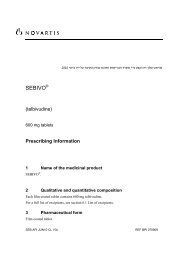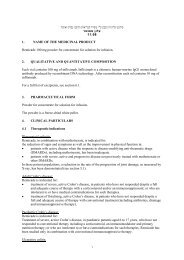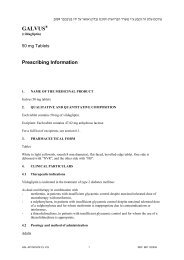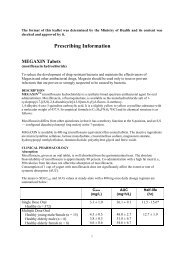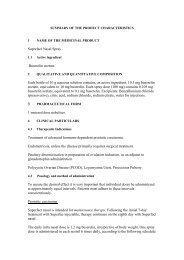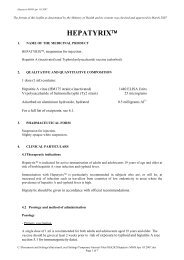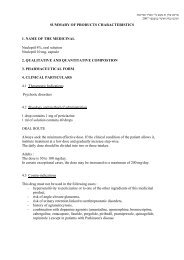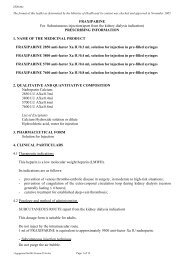CERVARIX® PRODUCT INFORMATION
CERVARIX® PRODUCT INFORMATION
CERVARIX® PRODUCT INFORMATION
You also want an ePaper? Increase the reach of your titles
YUMPU automatically turns print PDFs into web optimized ePapers that Google loves.
Cervarix MOH Apr. 04.2008<br />
The format of this leaflet as determined by the Ministry of Health and its content was checked and approved in April 2008<br />
DESCRIPTION<br />
CERVARIX ® <strong>PRODUCT</strong><br />
<strong>INFORMATION</strong><br />
Human Papillomavirus Vaccine Types 16 and 18<br />
(Recombinant, AS04 adjuvanted)<br />
CERVARIX contains recombinant C-terminally truncated L1 proteins from human papillomavirus (HPV)<br />
type-16 and type-18 each assembled as virus-like particles (VLPs). The HPV-16 and HPV-18 L1 antigens<br />
are prepared by recombinant DNA technology using a Baculovirus expression system in Trichoplusnia ni<br />
cells.<br />
HPV-16 and HPV-18 L1 antigens in CERVARIX are adjuvanted with AS04. This AS04 adjuvant system<br />
comprises aluminium hydroxide (Al(OH)3) and 3-O-desacyl-4’- monophosphoryl lipid A (MPL). The<br />
MPL within AS04 enhances the initiation of the immune response through the activation of innate<br />
immunity, leading to an improved cellular and humoral adaptive immune response.<br />
Each 0.5ml dose of CERVARIX contains 20 micrograms each of HPV-16 L1 and HPV-18 L1 proteins, 0.5<br />
milligrams of Al(OH)3 and 50 micrograms of MPL. CERVARIX also contains sodium chloride (NaCl)<br />
4.4 mg, sodium phosphate - monobasic (NaH2PO4.2 H2O) 624 micrograms and water for injection as<br />
excipients. CERVARIX does not contain a preservative.<br />
PHARMACOLOGY<br />
Epidemiological evidence confirms that persistent infection with oncogenic (high-risk) HPV types is the<br />
primary cause of cervical cancer and most precursor lesions. Persistent infection with at least one<br />
oncogenic HPV type is a necessary causal factor for pre-cancerous high-grade cervical epithelial<br />
abnormalities, for example, cervical intraepithelial neoplasia (CIN).<br />
Of the several known oncogenic HPV types, HPV types-16 and -18 are the two most prevalent; worldwide,<br />
they are responsible for approximately 70% of invasive cervical cancers and approximately 50% of CIN<br />
grades 2 or 3.<br />
Depending on the geographical region, a further 20% of invasive cervical cancer may be caused by seven<br />
HPV-16 or HPV-18 phylogenetically-related types that have similar biological properties. The<br />
phylogenetically-related types to HPV-16 are HPV-31, -33, -52, -58, -35, and the related types to HPV-18<br />
are HPV-45 and -59.<br />
Mechanism of action<br />
CERVARIX is a recombinant vaccine prepared from VLPs of the major L1 protein of HPV types 16 and<br />
18. Since VLPs contain no viral DNA, they cannot infect cells or reproduce. Animal studies suggest that<br />
the efficacy of VLPs is largely mediated by the development of a humoral immune response and cellmediated<br />
immunity.<br />
Transudation of anti-HPV IgG antibodies from the serum to the cervical mucosa is thought to be the<br />
primary mechanism of protection against persistent oncogenic HPV infection, the necessary cause of<br />
cervical cancer.<br />
C:\Documents and Settings\efrat.nisan\Local Settings\Temporary Internet Files\OLK242\Cervarix MOH Apr 04 2008.doc<br />
Page 1 of 14
CERVARIX ® Product Information<br />
CERVARIX is adjuvanted with AS04. In clinical trials CERVARIX adjuvanted with AS04 compared to<br />
the same antigens adjuvanted with aluminium hydroxide alone showed:<br />
- significantly higher antibody titres at least 2 fold higher (at all time points analysed up to 4 years after<br />
first dose);<br />
- significantly higher functional antibody titres (analysed up to 4 years after first dose);<br />
- B cell memory frequency approximately 2 fold higher (at all time points analysed up to 2 years after<br />
first dose).<br />
CLINICAL STUDIES<br />
Vaccine Efficacy<br />
The efficacy of CERVARIX is being assessed in 2 controlled, double-blind, randomised Phase II and III<br />
clinical studies (HPV-001/007 and HPV-008) that included a total of 19,778 women aged 15 to 25 years.<br />
Both of these studies are ongoing.<br />
Clinical trial HPV-001/007 is an ongoing study conducted in North America and Latin America. Study<br />
entry criteria were: negative for oncogenic HPV DNA (HPV-16, 18, 31, 33, 35, 39, 45, 51, 52, 56, 58, 59,<br />
66 and 68) in cervical samples, seronegative for HPV-16 and HPV-18 antibodies and normal cytology.<br />
These characteristics are representative of a population unlikely to have been exposed to oncogenic HPV<br />
types prior to vaccination (“oncogenic HPV-naive”).<br />
Clinical trial HPV-008 is an on-going study conducted in North America, Latin America, Europe, Asia<br />
Pacific and Australia. Pre-vaccination samples were collected for oncogenic HPV DNA (HPV-16, 18, 31,<br />
33, 35, 39, 45, 51, 52, 56, 58, 59, 66 and 68) testing and serum testing for HPV-16 and HPV-18 antibodies.<br />
Women were vaccinated regardless of baseline cytology and HPV status. These characteristics are<br />
representative of a “general population” including women exposed to HPV infection prior to vaccination.<br />
Subjects initially infected with a particular HPV type were not eligible for the efficacy assessment of that<br />
type.<br />
The primary endpoints in study HPV-001/007 are incident HPV-16 and/or HPV-18 infections.<br />
The primary endpoint in study HPV-008 is HPV-16 or HPV-18 related CIN2+.<br />
In both studies the following endpoints were evaluated:<br />
• CIN2+ (cervical intraepithelial neoplasia grade 2 and higher grade lesions)<br />
• CIN1+ (cervical intraepithelial neoplasia grade 1 and higher grade lesions)<br />
• Cytological abnormalities including atypical squamous cells of undetermined significance (ASC-<br />
US), low grade squamous intraepithelial lesions (LSIL), high grade squamous intraepithelial<br />
lesions (HSIL) and ASC-US of suspected high grade (ASC-H).<br />
• 12 month persistent infection (i.e. at least 2 positive specimens for the same HPV type over<br />
approximately a 12-month interval but no negative sample in between)<br />
• 6 month persistent infection (i.e. at least 2 positive specimens for the same HPV type over<br />
approximately a 6-month interval but no negative sample in between).<br />
Efficacy against HPV-16/18 in the “oncogenic HPV-naïve” population<br />
(Study HPV-001/007)<br />
Efficacy results in the “oncogenic HPV-naïve population” (seronegative by ELISA and HPV DNA<br />
negative by PCR in cervical samples at baseline) for virological, cytological and histological endpoints in<br />
C:\Documents and Settings\efrat.nisan\Local Settings\Temporary Internet Files\OLK242\Cervarix MOH Apr 04 2008.doc<br />
Page 2 of 14
CERVARIX ® Product Information<br />
study HPV-007 (Total Cohort i.e. women who received at least one vaccine dose) through 4.5 years<br />
following the first vaccine dose are presented in the tables 1 and 2 below.<br />
Table 1 Vaccine efficacy against incident infection associated with HPV-16 and/or HPV-18 (by PCR, cervical<br />
samples) (ATP cohort)<br />
Event type Group N n % (95% CI) P-value<br />
Incident CERVARIX 310 1 96.9 (81.3; 99.9)
CERVARIX ® Product Information<br />
the “general population” for histological endpoints in the interim analysis of study HPV-008 (Total<br />
Vaccinated Cohort i.e. women who received at least one vaccine dose) are presented in Tables 3, 4 and 5<br />
below.<br />
The planned interim efficacy analysis was triggered when an independent endpoint committee validated a<br />
requisite number of events of CIN2+, associated with HPV-16 or HPV-18 in the lesion as detected by<br />
PCR. In the pre-specified primary endpoint analysis, the observed vaccine efficacy (VE) against CIN2+<br />
associated with HPV-16 or HPV-18 was statistically significant (VE = 90.4% [53.4%; 99.3], p
CERVARIX ® Product Information<br />
Table 5 Summary of Vaccine Efficacy against CIN2+ associated with HPV-16/18 in HPV<br />
DNA negative subjects at baseline (regardless of initial serostatus) (Total vaccinated<br />
cohort, with and without Clinical Case Assignment) – Interim Analysis<br />
Event type Group N n % (97.9% CI*) P-value<br />
CIN2+*** CERVARIX 8293 2 91.6 (60.2; 99.4)
CERVARIX ® Product Information<br />
HPV-16 and HPV-18 are not responsible for all cervical cancers. Other oncogenic HPV types can also<br />
cause cervical cancer. Of these, HPV-45 and HPV-31 are the next most prevalent types worldwide. Study<br />
HPV-008 assessed persistent infection with the following oncogenic HPV types by PCR; HPV-16, 18, 31,<br />
33, 35, 39, 45, 51, 52, 56, 58, 59, 66 and 68 as a secondary endpoint. Recent studies have shown strong<br />
association between persistent infection with oncogenic HPV and high grade abnormalities (CIN 2 / CIN<br />
3).<br />
In the “general population” (the interim analysis of study HPV-008), CERVARIX has shown some<br />
efficacy against persistent infection caused by oncogenic HPV types other than HPV-16 and HPV-18. The<br />
confidence intervals that follow are 97.9% CI associated with the multiple statistical analyses. Vaccine<br />
efficacy against persistent infection (6-month definition) was 36.1% (CI: 0.5; 59.5) for HPV type 31,<br />
59.9% (CI: 2.6; 85.2) for HPV type 45 and 31.6 % (CI: 3.5; 51.9) for HPV-52, which supports crossprotection<br />
against these types. Vaccine efficacy against persistent infection (6-month definition) for all 12<br />
oncogenic HPV types combined excluding HPV-16 and HPV-18 was not statistically significant (9.0%;<br />
[CI: -5.1; 21.2]).<br />
Table 7: Summary of Vaccine Efficacy against persistent infection (6-month definition) for<br />
oncogenic types other than HPV-16 or HPV-18 in HPV DNA negative and seronegative<br />
subjects at baseline (Total vaccinated cohort) – interim analysis.<br />
Vaccine Efficacy<br />
Type* Persistent infection (6 months)<br />
HPV-45 59.9% [CI: 2.6%;85.2%]<br />
HPV-31 36.1% [CI:0.5%;59.5%]<br />
HPV-33 36.5% [CI:
CERVARIX ® Product Information<br />
The immunogenicity induced by three doses of CERVARIX has been evaluated in 5,303 female subjects<br />
from 10 to 55 years of age.<br />
In clinical trials, 99.9% of initially seronegative subjects had seroconverted to both HPV type 16 and 18<br />
one month after the third dose. Vaccine-induced IgG Geometric Mean Titres (GMT) were well above<br />
titres observed in women previously infected but who cleared HPV infection (natural infection). Initially<br />
seropositive and seronegative subjects reached similar titres after vaccination.<br />
Immunogenicity in women aged 15 to 25 years<br />
The immune response against HPV-16 and HPV-18 was evaluated up to 53 months post dose 1, in study<br />
HPV-001/007 in women aged 15 to 25 years at the time of vaccination. Results are presented in Figure 1<br />
below:<br />
Figure 1 Persistence of Anti-HPV-16 and Anti-HPV-18 Antibodies (Binding ELISA)<br />
(According To Protocol Cohort for Immunogenicity)<br />
log<br />
Anti-HPV-16 IgG<br />
1000<br />
100<br />
10<br />
1<br />
1<br />
6<br />
0<br />
100%<br />
17<br />
100<br />
99.7<br />
0 0<br />
% seropositive<br />
99<br />
month 0 month 7 month 12 month 18 [M2 -M32 [M3 -M38 [M3 -M44 [M4 -M50 [M5 - M53<br />
HP - 00 HP -00<br />
Months follow up time<br />
10<br />
C:\Documents and Settings\efrat.nisan\Local Settings\Temporary Internet Files\OLK242\Cervarix MOH Apr 04 2008.doc<br />
Page 7 of 14<br />
99<br />
10<br />
100<br />
12<br />
Vaccine HPV - 16<br />
Placeb Ig<br />
100<br />
11<br />
100<br />
12
CERVARIX ® Product Information<br />
log (ELU/ml)<br />
10000<br />
1000<br />
100<br />
10<br />
1<br />
10%<br />
0%<br />
100%<br />
17%<br />
100%<br />
0% 0%<br />
month 0 month 7 month 12 month 18 [M25-M32] [M33-M38] [M39-M44] [M45-M50] [M51-M53]<br />
Vaccine-induced IgG Geometric Mean Titres (GMT) for both HPV-16 and HPV-18 peaked at month 7 and<br />
then declined to reach a plateau from month 18 up to end of the follow-up (month 53). At the end of the<br />
follow-up period, GMTs for both HPV 16 and 18 were still at least 14-fold higher than titres observed in<br />
women previously infected but who cleared HPV infection (natural infection). Nevertheless, natural<br />
infection antibody levels may not consistently protect against subsequent infections.<br />
In the interim analysis of study HPV-008 (“general population”), immunogenicity at month 7 was similar<br />
to the response observed in study HPV-001/007 (“HPV-naive population”).<br />
Bridging the efficacy of CERVARIX demonstrated in 15 to 25 year olds to other age groups<br />
In two clinical trials performed in girls and adolescents aged 10 to 14 years, all subjects seroconverted to<br />
both HPV type 16 and 18 after the third dose (at month 7) with GMTs at least 2-fold higher compared to<br />
women aged 15 to 25 years.<br />
In a clinical study performed in women aged 26 to 55 years, after vaccination, 100% of initially<br />
seronegative subjects had seroconverted to both HPV-16 and HPV-18 antigens in all age groups (at month<br />
7) and remained seropositive up to month 18. As observed with other vaccines, the immune response<br />
elicited by the vaccine decreases with increasing age. This is not unexpected since this reflects the<br />
senescence of the immune system. Furthermore, GMTs remained in the same range or higher as those<br />
observed in the plateau phase of the long term follow up in the efficacy study HPV-001/007 in women<br />
aged 15-25 years.<br />
On the basis of immunogenicity data observed in females aged 10 to 14 years and aged 26 to 45 years, the<br />
efficacy of Cervarix is inferred from 10 to 45 years.<br />
Immunogenicity in seropositive women<br />
The vaccination of women who were initially seropositive for HPV-16 or HPV-18 or both types has shown<br />
that the presence of anti-HPV-16 and/or anti-HPV-18 antibodies from natural infection does not affect the<br />
immune response to the HPV-16/18 vaccine.<br />
Immunogenicity in males<br />
To date, the vaccine has not been evaluated in males.<br />
Anti-HPV-18 IgG<br />
99.7%<br />
HPV-001 HPV-007<br />
Months follow up time<br />
C:\Documents and Settings\efrat.nisan\Local Settings\Temporary Internet Files\OLK242\Cervarix MOH Apr 04 2008.doc<br />
Page 8 of 14<br />
% seropositive<br />
99%<br />
7%<br />
99%<br />
12%<br />
99%<br />
Vaccine HPV-18 IgG<br />
Placebo IgG<br />
16%<br />
100%<br />
13%<br />
100%<br />
9%
CERVARIX ® Product Information<br />
INDICATIONS<br />
CERVARIX is indicated in females from 10 to 45 years of age for the prevention of cervical cancer by<br />
protecting against incident and persistent infections, cytological abnormalities including atypical squamous<br />
cells of undetermined significance (ASC-US) and cervical intraepithelial neoplasia (CIN), CIN 1 and precancerous<br />
lesions (CIN 2 and CIN 3) caused by human papillomavirus types 16 and 18. Immunogenicity<br />
studies have been conducted in females aged 10 to 14 years and 26 to 45 years to link efficacy in females<br />
aged 15 to 25 years to other populations.<br />
CONTRAINDICATIONS<br />
CERVARIX should not be administered to subjects with known hypersensitivity to any component of the<br />
vaccine (See Description).<br />
PRECAUTIONS<br />
As with other vaccines, the administration of CERVARIX should be postponed in subjects suffering from<br />
acute severe febrile illness. However, the presence of a minor infection, such as a cold, should not result in<br />
the deferral of vaccination.<br />
It is good clinical practice to precede vaccination by a review of the medical history (especially with<br />
regard to previous vaccination and possible occurrence of undesirable events) and a clinical examination.<br />
As with all injectable vaccines, appropriate medical treatment and supervision should always be readily<br />
available in case of a rare anaphylactic event following the administration of the vaccine.<br />
As for other vaccines administered intramuscularly, CERVARIX should be given with caution to<br />
individuals with thrombocytopenia or any coagulation disorder since bleeding may occur following an<br />
intramuscular administration to these subjects.<br />
CERVARIX should under no circumstances be administered intravascularly or intradermally.<br />
No data are available on subcutaneous administration of CERVARIX.<br />
As with any vaccine, a protective immune response may not be elicited in all vaccinees.<br />
CERVARIX is a prophylactic vaccine. CERVARIX is not intended to be a treatment for persistent<br />
infection or for HPV-related lesions present at the time of vaccination. CERVARIX is not intended to<br />
prevent progression of established HPV-related lesions present at the time of vaccination.<br />
HPV-16 and HPV-18 are not responsible for all cervical cancers (see Clinical Studies). Other oncogenic<br />
HPV types can also cause cervical cancer. HPV infections and related clinical outcomes due to these other<br />
oncogenic types may not be prevented by vaccination.<br />
Vaccination is primary prevention and is not a substitute for regular cytological screening (secondary<br />
prevention) or for precautions against exposure to HPV and sexually transmitted diseases.<br />
There are no data on the use of CERVARIX in subjects with impaired immune responsiveness such as<br />
HIV infected patients or patients receiving immunosuppressive treatment. For these individuals an<br />
C:\Documents and Settings\efrat.nisan\Local Settings\Temporary Internet Files\OLK242\Cervarix MOH Apr 04 2008.doc<br />
Page 9 of 14
CERVARIX ® Product Information<br />
adequate immune response may not be elicited.<br />
Duration of protection has not been established. Limited data support protective efficacy for 4.5 years<br />
after the first dose. Long-term studies are ongoing to establish the duration of protection.<br />
EFFECTS on FERTILITY<br />
Fertility was not affected in female rats given double the clinical dose of CERVARIX by intramuscular<br />
administration 30 days prior to mating.<br />
USE in PREGNANCY (Category B2)<br />
Specific studies of the vaccine in pregnant women were not conducted. Pregnancy testing was performed<br />
prior to each vaccine administration and vaccination was discontinued in case of a positive pregnancy test.<br />
In all clinical trials, subjects were instructed to take precautions to avoid pregnancy until 2 months after<br />
the last vaccination. During prelicensure clinical development, a total of 1,737 pregnancies (n = 870 for<br />
CERVARIX) were reported. The proportions of pregnant subjects who experienced specific outcomes<br />
(e.g., normal infant, abnormal infants including congenital anomalies, premature birth, and spontaneous<br />
abortion), were similar between treatment groups. Sub-analyses were conducted to describe pregnancy<br />
outcomes in 415 women (n = 210 for CERVARIX) who had their last menstrual period within 30 days<br />
prior to, or 45 days after a vaccine dose. The majority of subjects gave birth to normal infants (9.4% of<br />
pregnancies were ongoing at the time of the analysis). Apart from elective procedures, spontaneous<br />
abortion was next in frequency, reported in a total of 8.9% of subjects: 11% for CERVARIX, 5.7% for<br />
Hepatitis A Vaccine control, and 13.8% for placebo. The background rate of spontaneous abortion in<br />
individuals who are known to be pregnant has been reported to be 13-16%. These data are insufficient to<br />
recommend use of CERVARIX during pregnancy. Vaccination should therefore be postponed until after<br />
pregnancy.<br />
The effect of CERVARIX on embryo-foetal, peri-natal and post-natal survival and development has not<br />
been prospectively evaluated in clinical trials.<br />
No adverse effects on embryofetal development, parturition or postnatal development were observed in<br />
pregnant rats that received double the clinical dose of vaccine on 4 occasions during gestation.<br />
USE in LACTATION<br />
CERVARIX should only be used during breast-feeding when the possible advantages outweigh the<br />
possible risks.<br />
The effect on breastfed infants of the administration of CERVARIX to their mothers has not been<br />
evaluated in clinical studies.<br />
Serological data suggest a transfer of anti-HPV-16 and anti-HPV-18 antibodies via the milk during the<br />
lactation period in rats. However, it is unknown whether vaccine-induced antibodies are excreted in<br />
human breast milk.<br />
Genotoxicity<br />
The genotoxic potential of CERVARIX has not been investigated. The adjuvant substance MPL has been<br />
tested for genotoxicity in a series of in vitro assays (bacterial mutation and chromosomal aberration) and<br />
C:\Documents and Settings\efrat.nisan\Local Settings\Temporary Internet Files\OLK242\Cervarix MOH Apr 04 2008.doc<br />
Page 10 of 14
CERVARIX ® Product Information<br />
an in vivo rat micronucleus test. Under the condition of these assays, MPL did not cause genetic damage.<br />
Carcinogenicity<br />
The carcinogenic potential of CERVARIX has not been investigated.<br />
ABILITY TO PERFORM TASKS THAT REQUIRE JUDGEMENT, MOTOR OR<br />
COGNITIVE SKILLS<br />
No studies on the effects on the ability to drive or use machines have been performed.<br />
INTERACTIONS<br />
Use with other vaccines<br />
There are no data on concomitant administration of CERVARIX with hepatitis B vaccine, varicella<br />
vaccine and dTpa vaccine. If CERVARIX is to be given at the same time as another injectable vaccine,<br />
the vaccines should always be administered at different injection sites.<br />
Use with hormonal contraceptive<br />
In clinical studies, approximately 60% of women who received CERVARIX used hormonal<br />
contraceptives. There is no evidence that the use of hormonal contraceptives has an impact on the efficacy<br />
of CERVARIX.<br />
Use with systemic immunosuppressive medications<br />
As with other vaccines it may be expected that in patients receiving immunosuppressive treatment, an<br />
adequate response may not be elicited.<br />
ADVERSE REACTIONS<br />
In total approximately 45,000 doses of CERVARIX were administered to approximately 16,000 subjects<br />
aged 10 – 68 years. These subjects were followed to assess the safety of the vaccine.<br />
Adverse reactions occurring after vaccination during these studies were reported. The most common<br />
reaction observed after vaccine administration was injection site pain which occurred after 78% of all<br />
doses. The majority of these reactions were of mild to moderate severity and were not long lasting.<br />
The following table summarises data from seven pivotal studies for solicited local and general symptoms<br />
reported during a 7-day follow-up period after vaccination.<br />
Table 8 Pooled safety analysis: Incidence of solicited local and general symptoms reporting<br />
during the 7-day (Days 0-6) post-vaccination period following all doses (Total vaccinated cohort)<br />
CERVARIX ALU HAV360 HAV720<br />
Symptom Type N % N % N % N %<br />
Solicited local symptoms<br />
Pain<br />
All 22806 78.0 4485 52.5 3059 41.3 8750 58.9<br />
Grade 3 22806 6.3 4485 3.4 3059 0.8 8750 1.8<br />
Redness (mm) All 22806 29.6 4485 10.6 3059 13.7 8750 16.0<br />
>50 22806 0.6 4485 0.0 3059 0.1 8750 0.0<br />
Swelling (mm)<br />
All 22806 25.8 4485 8.2 3059 8.6 8750 10.1<br />
>50 22806 1.1 4485 0.0 3059 0.2 8750 0.2<br />
Solicited general symptoms<br />
C:\Documents and Settings\efrat.nisan\Local Settings\Temporary Internet Files\OLK242\Cervarix MOH Apr 04 2008.doc<br />
Page 11 of 14
CERVARIX ® Product Information<br />
Fatigue<br />
All 22802 33.1 4481 22.8 3058 24.6 8751 35.3<br />
Grade 3 22802 1.5 4481 1.2 3058 1.1 8751 1.3<br />
Gastrointestinal All 22802 12.9 4481 11.6 3058 11.3 8751 14.0<br />
symptoms Grade 3 22802 0.7 4481 0.7 3058 0.8 8751 0.7<br />
Headache All 22802 29.5 4481 25.9 3058 25.4 8751 30.8<br />
Grade 3 22802 1.6 4481 1.2 3058 1.6 8751 1.4<br />
Arthralgia All 21222 10.2 2916 7.6 3058 9.3 8751 8.6<br />
Grade 3 21222 0.4 2916 0.2 3058 0.2 8751 0.3<br />
Myalgia<br />
All 21222 28.1 2916 9.9 3058 17.1 8751 26.5<br />
Grade 3 21222 1.4 2916 0.2 3058 0.5 8751 0.6<br />
Fever (Axillary) All 22802 5.1 4481 5.2 3058 6.8 8751 4.6<br />
(°C) >39°C 22802 0.2 4481 0.2 3058 0.6 8751 0.1<br />
Rash<br />
All 22802 3.8 4481 2.7 3058 2.6 8751 3.6<br />
Grade 3 22802 0.1 4481 0.0 3058 0.1 8751 0.1<br />
CERVARIX group (Studies HPV-001, 008 subset, -012, -013, -014, -015 subset and -016: girls and women 10 years and<br />
above)<br />
ALU = AI(OH)3 control group (Studies HPV-001 and -015 subset; adolescent girls and women 15 years and above)<br />
HAV360 = Hepatitis A control group containing 360 EU hepatitis A antigen per dose (Study HPV-013; girls 10-14 years of<br />
age)<br />
HAV720 = Hepatitis A control group containing 720 EU hepatitis A antigen per dose (Study HPV-008 subset; adolescent girls<br />
and women 15-25 years of age)<br />
N=number of documented doses<br />
% = percentage of doses followed by at least one type of symptom<br />
Grade 3 Pain: Spontaneously painful (HPV-001) or Pain that prevents normal activity (HPV-008, HPV-012, HPV-013, HPV-<br />
014, HPV-015 and HPV-016)<br />
Other events<br />
Other adverse reactions considered as being at least possibly related to vaccination have been categorised<br />
by frequency.<br />
Frequencies are reported as:<br />
Very common (≥1/10)<br />
Common (≥1/100 to
CERVARIX ® Product Information<br />
Very common: injection site reactions including pain, redness, swelling; fatigue<br />
Common: fever (≥38°C)<br />
Uncommon: other injection site reactions such as induration, local paraesthesia<br />
DOSAGE AND ADMINISTRATION<br />
Dosage<br />
The primary vaccination course consists of three doses.<br />
The recommended vaccination schedule is 0, 1, 6 months. If flexibility in the vaccination schedule is<br />
necessary, the second dose can be administered between 1 month and 2.5 months after the first dose.<br />
The necessity for a booster dose has yet to be established (see “Clinical Studies”).<br />
Method of administration<br />
CERVARIX is for intramuscular injection in the deltoid region (see “Precautions”, “Drug Interactions”).<br />
The content of the syringe/vial should be inspected visually both before and after shaking for any foreign<br />
particulate matter and/or abnormal physical appearance prior to administration.<br />
In the event of either being observed, discard the vaccine.<br />
The vaccine should be well shaken before use.<br />
CERVARIX syringe or vials are for single use in a single patient only. Any unused product of waste<br />
material should be disposed of in accordance with local requirements.<br />
OVERDOSAGE<br />
No case of overdose has been reported.<br />
STORAGE<br />
CERVARIX must be stored at +2°C to +8°C. DO NOT FREEZE, discard if vaccine has been frozen. The<br />
vaccine should be stored in the original package in order to protect from light.<br />
In case of temporary storage of the vaccine outside refrigerator, experimental data have shown that the<br />
vaccine is stable when stored at temperatures up to 37°C for 1 week. These data are not recommendations<br />
for storage.<br />
The shelf life of CERVARIX is three (3) years from the date of manufacture at temperatures of +2°C to<br />
+8°C. The expiry date of the vaccine is indicated on the label and packaging.<br />
PRESENTATIONS<br />
CERVARIX is presented as a turbid white suspension. Upon storage, a fine white deposit with a clear<br />
colourless supernatant can be observed. This does not constitute a sign of deterioration.<br />
C:\Documents and Settings\efrat.nisan\Local Settings\Temporary Internet Files\OLK242\Cervarix MOH Apr 04 2008.doc<br />
Page 13 of 14
CERVARIX ® Product Information<br />
CERVARIX is presented as<br />
- 0.5 ml of suspension in a pre-filled syringe (type I glass) with a plunger stopper (rubber butyl) with<br />
or without needles in pack sizes of 1 and 10, or<br />
- 0.5 ml of suspension in vial (type I glass) with a stopper (rubber butyl) in pack sizes of 1, 10 and<br />
100.<br />
Not all pack sizes may be marketed.<br />
MANUFACTURER:<br />
GlaxoSmithKline Biologicals s.a.<br />
Rue de l'Institut, 89<br />
1330 Rixensart<br />
Belgium<br />
LICENCE HOLDER<br />
GlaxoSmithKline (Israel) Ltd.<br />
25 Basel St., Petach-Tikva 49002<br />
LICENCE NUMBER<br />
138-09-31676<br />
----------------------------<br />
®CERVARIX is a registered trademark of the GlaxoSmithKline group of companies<br />
C:\Documents and Settings\efrat.nisan\Local Settings\Temporary Internet Files\OLK242\Cervarix MOH Apr 04 2008.doc<br />
Page 14 of 14



